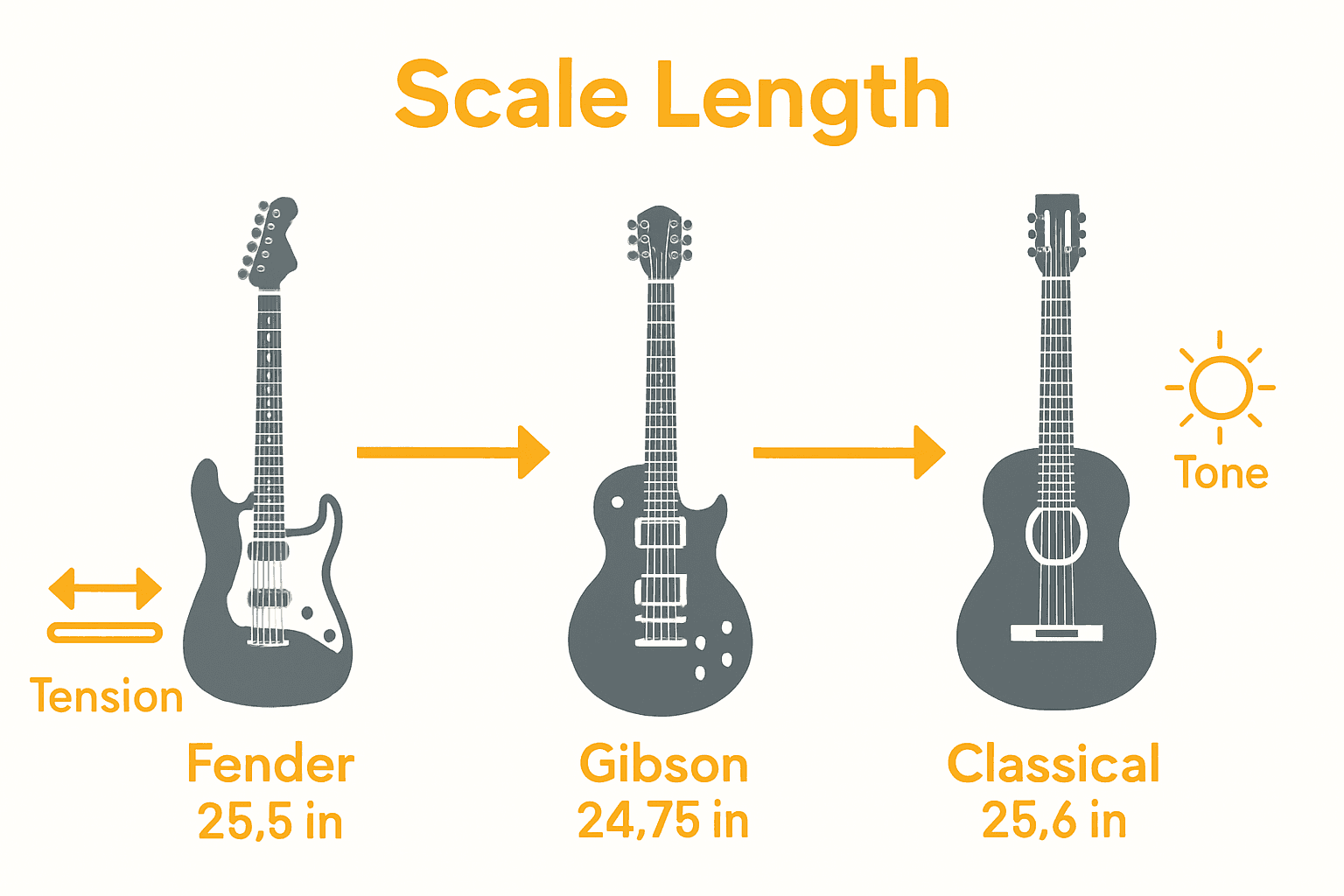String length on a guitar does more than you might think. Even a difference of less than an inch in scale length can completely change how a guitar feels and sounds. This simple measurement can control fret spacing, string tension, and even the warmth or brightness of your tone. Musicians who understand scale length are able to find an instrument that matches both their comfort and musical style, setting the stage for better playing and expressive sound.
Table of Contents
- Defining Guitar Scale Length And Its Importance
- Major Scale Length Variations And Examples
- How Scale Length Affects Tone And Playability
- Comparing Guitar Scale Lengths Across Brands
- Choosing The Right Scale Length For Your Needs
Key Takeaways
| Point | Details |
|---|---|
| Impact of Scale Length | Guitar scale length affects tone, playability, fret spacing, and string tension, influencing a musician’s choice of instrument. |
| Personalization is Key | Selection of scale length should consider hand size, playing style, and genre, providing a more tailored playing experience. |
| Brand Variations | Major guitar brands have specific scale lengths that shape their sound and feel, with Fender and Gibson exemplifying contrasting approaches. |
| Comfort and Style Considerations | Musicians should assess comfort and genre relevance when choosing scale lengths, as it directly influences technique and expression. |
Defining Guitar Scale Length and its Importance
Guitar scale length represents the vibrating distance of a guitar string between the nut and bridge saddle - a critical measurement that fundamentally shapes an instrument’s playability and sound characteristics. Andertons Blog highlights how this measurement significantly impacts fret spacing, string tension, and overall tone production.
At its core, scale length determines how strings interact with the guitar’s physical structure. Longer scale lengths typically generate brighter tones with increased string tension, creating a more articulate and precise sound. Conversely, shorter scales produce warmer tones with reduced string tension, offering players a more relaxed playing experience. This fundamental difference means musicians can select instruments that align with their technical requirements and tonal preferences.
Understanding scale length goes beyond mere technical specification - it directly influences a guitarist’s playing comfort and musical expression. Different scale lengths affect string feel, bend characteristics, and overall instrument responsiveness. Professional and amateur musicians alike must consider these nuanced factors when selecting an instrument. For guitarists seeking to explore more about instrument sizing, our guide on choosing guitar sizes provides additional insights into making informed instrument selections.
Musicians should recognize that scale length is not a one-size-fits-all specification. Factors like hand size, playing style, genre, and personal comfort all intersect with this critical measurement. Whether you prefer the tight responsiveness of a longer scale or the fluid playability of a shorter one, understanding scale length empowers you to make more deliberate choices in your musical journey.
Major Scale Length Variations and Examples
Guitar scale lengths vary significantly across different instrument types and brands, offering musicians a range of tonal and playing experiences. Wikipedia reveals that classical guitars typically feature a 25.6-inch scale length, while steel-string acoustic guitars range between 24 and 25.5 inches, demonstrating the nuanced differences across musical styles.
Guitarfluence highlights two prominent electric guitar scale length standards that dramatically influence sound and feel. Fender guitars like the Stratocaster and Telecaster maintain a 25.5-inch scale, producing higher string tension and a brighter, more cutting tone. In contrast, Gibson models such as the Les Paul utilise a shorter 24.75-inch scale, delivering lower string tension and a warmer, more rounded sound.
Beyond these standard measurements, musicians can explore various scale length options tailored to specific playing preferences. Shorter scales around 24 inches provide easier playability for smaller hands or those preferring less string tension. Longer scales exceeding 25.5 inches offer increased note definition and improved intonation, particularly beneficial for genres requiring precise articulation like jazz or progressive rock.
Interestingly, scale length variations extend beyond electric guitars. Bass guitars, for instance, often feature longer scales to accommodate their lower frequencies, while baritone guitars might employ extended scale lengths to maintain tension and clarity across lower tunings. These subtle differences underscore how scale length is not merely a technical specification, but a critical design element that profoundly shapes an instrument’s musical character and player experience.
IMAGE:descriptive_key_1] For guitarists seeking to delve deeper into instrument selection, our [guide on choosing guitar sizes offers comprehensive insights into making informed decisions.
How Scale Length Affects Tone and Playability
GuitarPlayer reveals that scale length is a critical factor determining a guitar’s fundamental voice and playing characteristics. Harmonic spacing plays a crucial role in this dynamic, with longer scales producing more widely spaced harmonics that result in a chime-like tone and tighter low-end response. Shorter scales, by contrast, generate more closely packed harmonics, delivering a warmer and thicker tonal profile.
String tension emerges as another pivotal aspect influenced by scale length. FindMyGuitar explains that longer scales inherently increase string tension, which translates to a brighter tone and wider fret spacing. This characteristic can be challenging for musicians with smaller hands, potentially requiring more finger stretching and strength. Conversely, shorter scales reduce string tension, creating a more relaxed playing experience with closer fret spacing that facilitates easier chord formations and note bending.
The tonal implications of scale length extend beyond mere frequency response. Guitarists can strategically select scale lengths to complement their playing style and genre requirements. Jazz and progressive rock musicians might prefer longer scales for enhanced note definition and articulation, while blues and rock players often gravitate towards shorter scales for their warm, responsive feel. These nuanced differences mean that scale length is not just a technical specification, but a critical design element that profoundly shapes musical expression.
Musicians seeking to explore the intricacies of guitar tone might find additional insights in our guide to understanding guitar tone. Ultimately, the relationship between scale length, tone, and playability is a delicate balance that invites personal exploration and experimentation.
Comparing Guitar Scale Lengths Across Brands
Andertons Blog illuminates the distinctive scale length variations among major guitar manufacturers, revealing how these subtle differences profoundly impact instrument performance. Fender and Gibson, two iconic guitar brands, exemplify this variation with their contrasting approaches to scale length design. Fender guitars traditionally maintain a 25.5-inch scale length, which generates higher string tension and produces a brighter, more articulate tone characteristic of their classic models like the Stratocaster and Telecaster.
In contrast, Gibson guitars typically feature a shorter 24.75-inch scale length, creating a markedly different playing experience. This reduced scale length results in lower string tension, delivering a warmer, more rounded tone that has become synonymous with Les Paul and SG models. These nuanced differences mean that musicians can choose instruments that align precisely with their tonal preferences and playing styles, transforming scale length from a technical specification into a crucial musical design element.
Beyond these two legendary brands, other manufacturers have developed unique scale length strategies. PRS (Paul Reed Smith) guitars often implement a middle-ground approach, utilizing scale lengths around 25 inches to balance tonal characteristics. Smaller boutique builders might experiment with even more varied scale lengths, creating instruments tailored to specific musical genres or player preferences. These variations underscore how scale length serves as a critical tool for sound sculpting and musical expression.
For guitarists interested in exploring the intricacies of instrument design, our guide to guitar brands offers additional insights into the unique characteristics of different manufacturers. Each brand’s approach to scale length represents a sophisticated balance between tradition, innovation, and musical functionality, inviting musicians to discover instruments that truly resonate with their individual creative voice.

Choosing the Right Scale Length for Your Needs
Guitarfluence emphasises that selecting the ideal scale length is a nuanced decision involving multiple critical factors. The fundamental considerations include instrument feel, string tension, tonal characteristics, overall playability, and tuning stability. Longer scale lengths around 25.5 inches offer musicians a tighter playing experience with enhanced note definition, producing a brighter tone that excels in clean picking and maintains exceptional intonation across the fretboard.
Physical ergonomics play a significant role in scale length selection. Players with smaller hands might find shorter scale lengths (around 24.75 inches) more comfortable, as they require less finger stretching and provide a looser feel. These shorter scales facilitate easier string bending and lead playing techniques, making them particularly appealing for blues, rock, and soloing styles. The warmer tone associated with shorter scales can also complement genres that prioritize expressive, fluid playing approaches.
Beyond personal physical comfort, musical genre and playing style become crucial considerations. Jazz and progressive musicians often gravitate towards longer scales for precise articulation, while blues and indie players might prefer the more responsive characteristics of shorter scales. Intermediate players can experiment with medium-scale lengths as a balanced compromise, allowing greater flexibility in technique and tonal exploration. The key is recognizing that scale length is not a universal solution but a personalised choice reflecting individual musical expression.
For guitarists seeking deeper insights into instrument selection, our guide to exploring different guitar styles offers comprehensive guidance. Ultimately, the perfect scale length represents a harmonious intersection between technical specifications and personal musical intuition, inviting musicians to discover an instrument that feels like a natural extension of their creative voice.
Find Your Perfect Guitar Scale Length at MusicStreet
Choosing the right guitar scale length can feel overwhelming given how much it influences your playing comfort and tone. Whether you want the bright articulation of a longer 25.5-inch scale or the warm, relaxed feel of a shorter 24.75-inch scale, understanding this key detail helps you find an instrument that truly matches your style. At MusicStreet, we appreciate how crucial scale length is for your musical expression and physical ease.

Explore our carefully curated selection of premium guitars where detailed listings make it simple to compare scale lengths and feel the difference for yourself. Plus, visit our physical store in Huntingdon if you want expert advice and hands-on experience. Begin your journey with us now and discover how the right scale length enhances every note you play. Visit MusicStreet.co.uk to shop, learn, and connect with a community passionate about quality guitars and inspired playing.
Frequently Asked Questions
What is guitar scale length?
Guitar scale length is the distance between the nut and the bridge saddle of a guitar string. It fundamentally shapes an instrument’s playability and sound characteristics.
How does scale length affect guitar tone?
Longer scale lengths generally produce brighter tones and increased string tension, while shorter scales yield warmer tones with less tension. This impacts harmonic spacing and overall tonal profile.
What are the common scale lengths for different types of guitars?
Classical guitars typically feature a 25.6-inch scale length, while steel-string acoustic guitars range between 24 to 25.5 inches. Electric guitars like Fender models maintain a 25.5-inch scale, while Gibson models use a 24.75-inch scale.
How should I choose the right scale length for my playing style?
Consider your hand size, preferred playing style, and musical genre. Longer scales offer enhanced definition suited for jazz and progressive styles, while shorter scales provide easier playability for blues and rock musicians.





Share:
How to Clean a Guitar for a Spotless, Professional Finish
Best 7 Electric Guitar and Amp for Beginners – Expert Comparison 2025